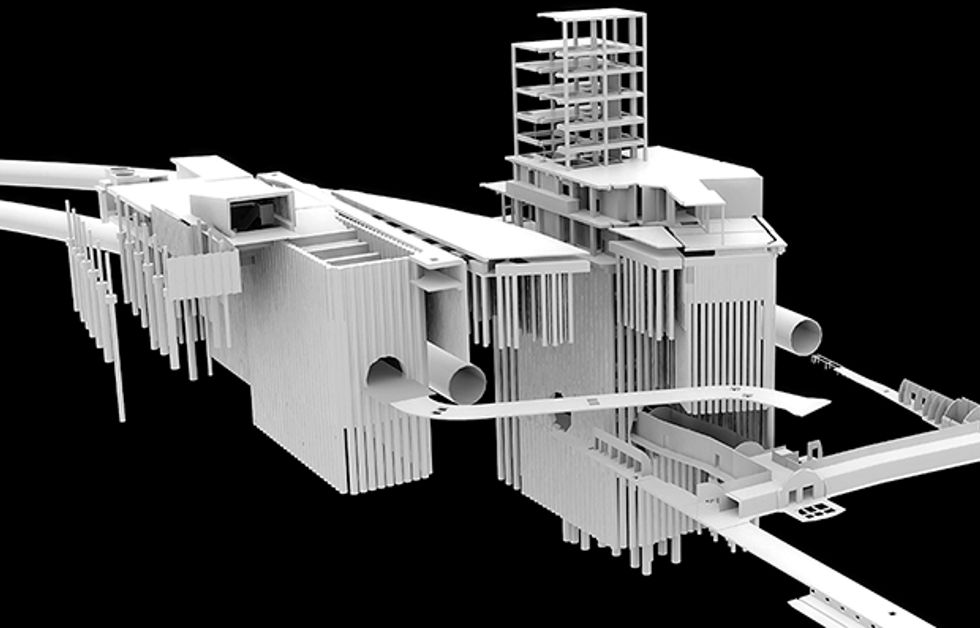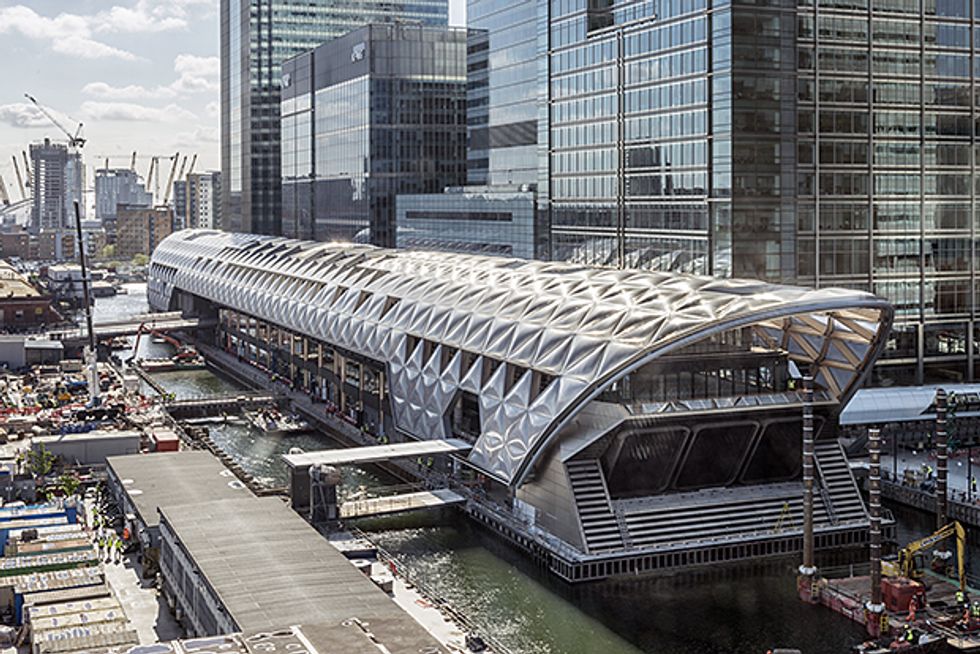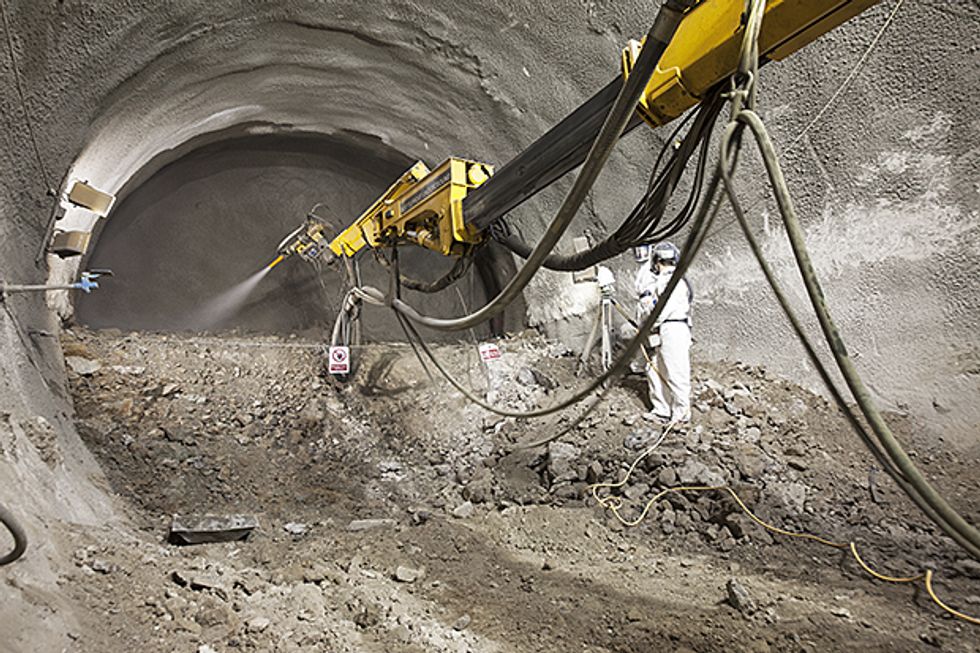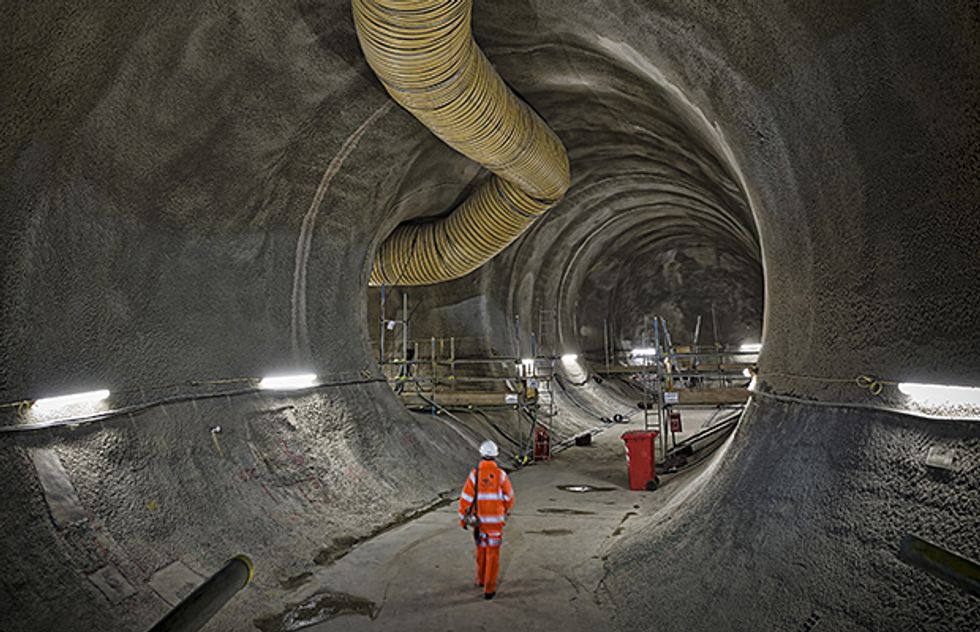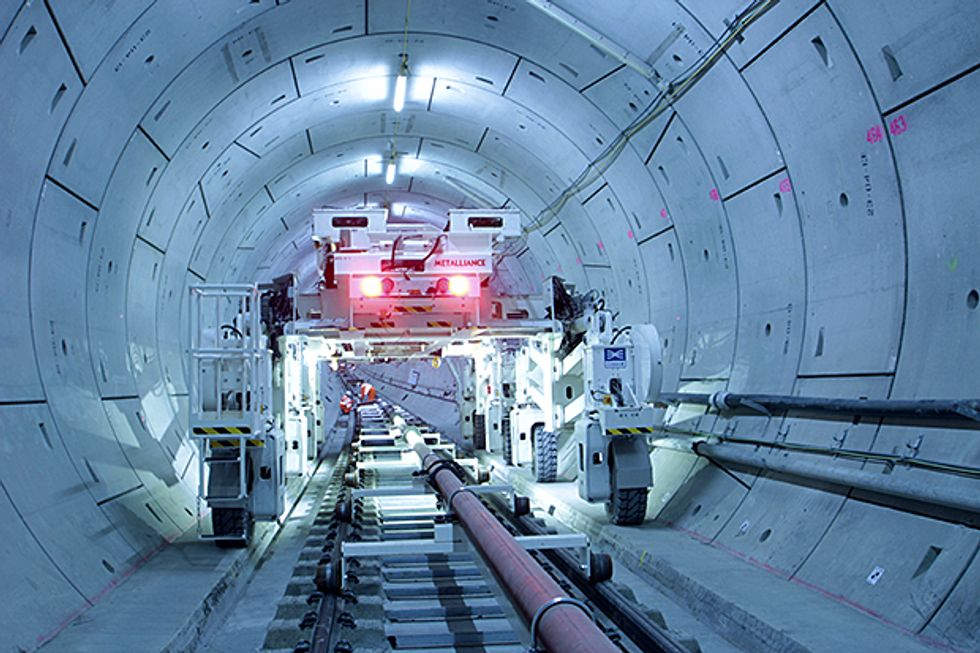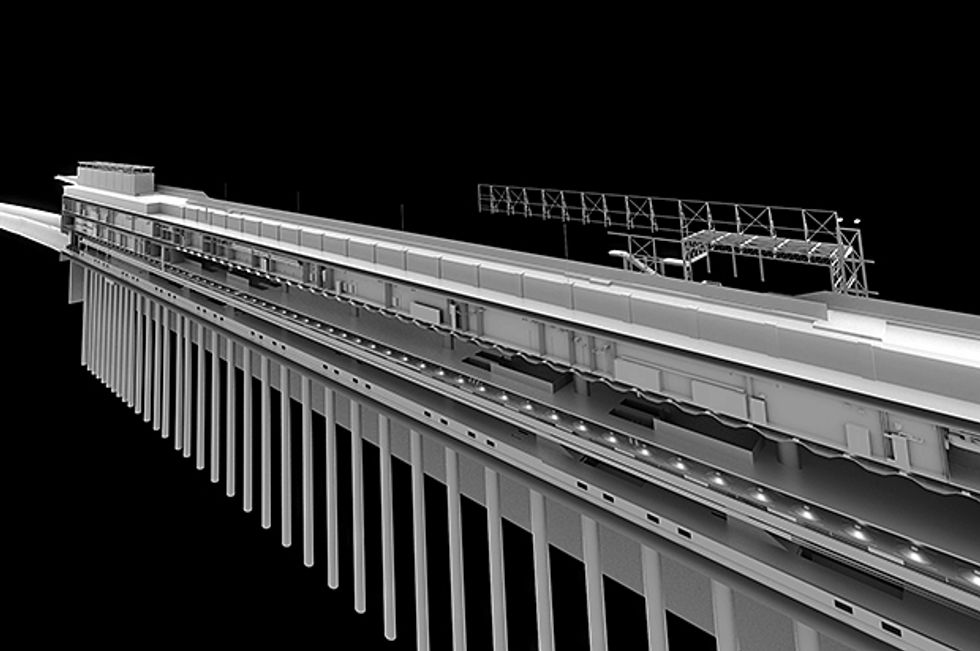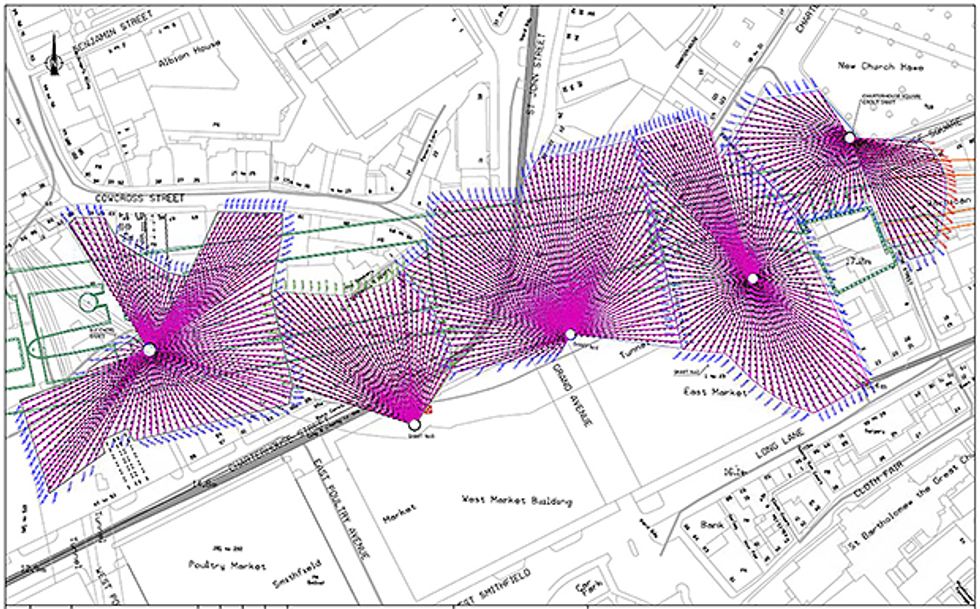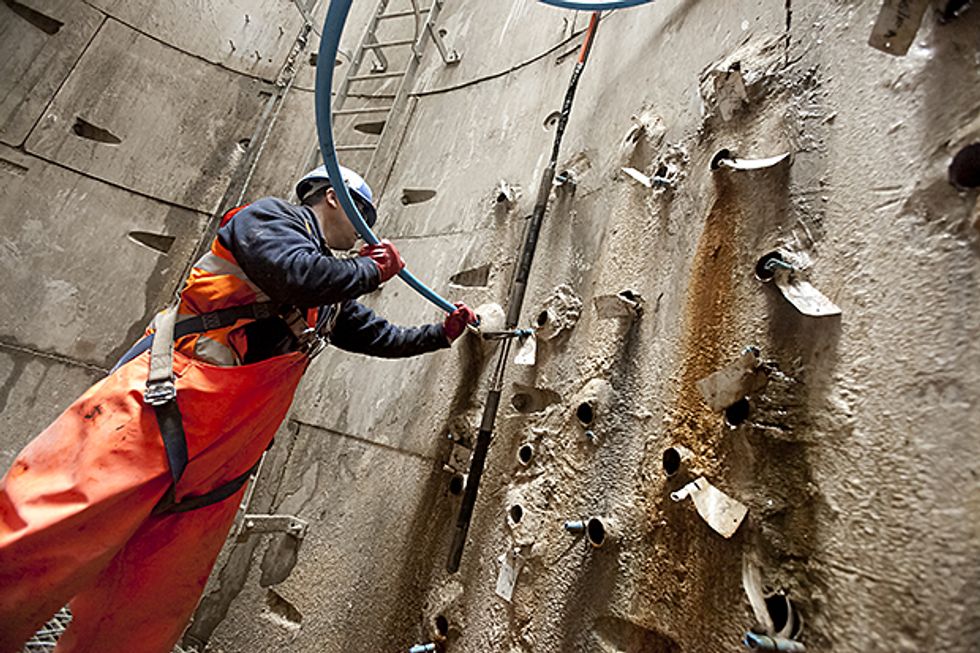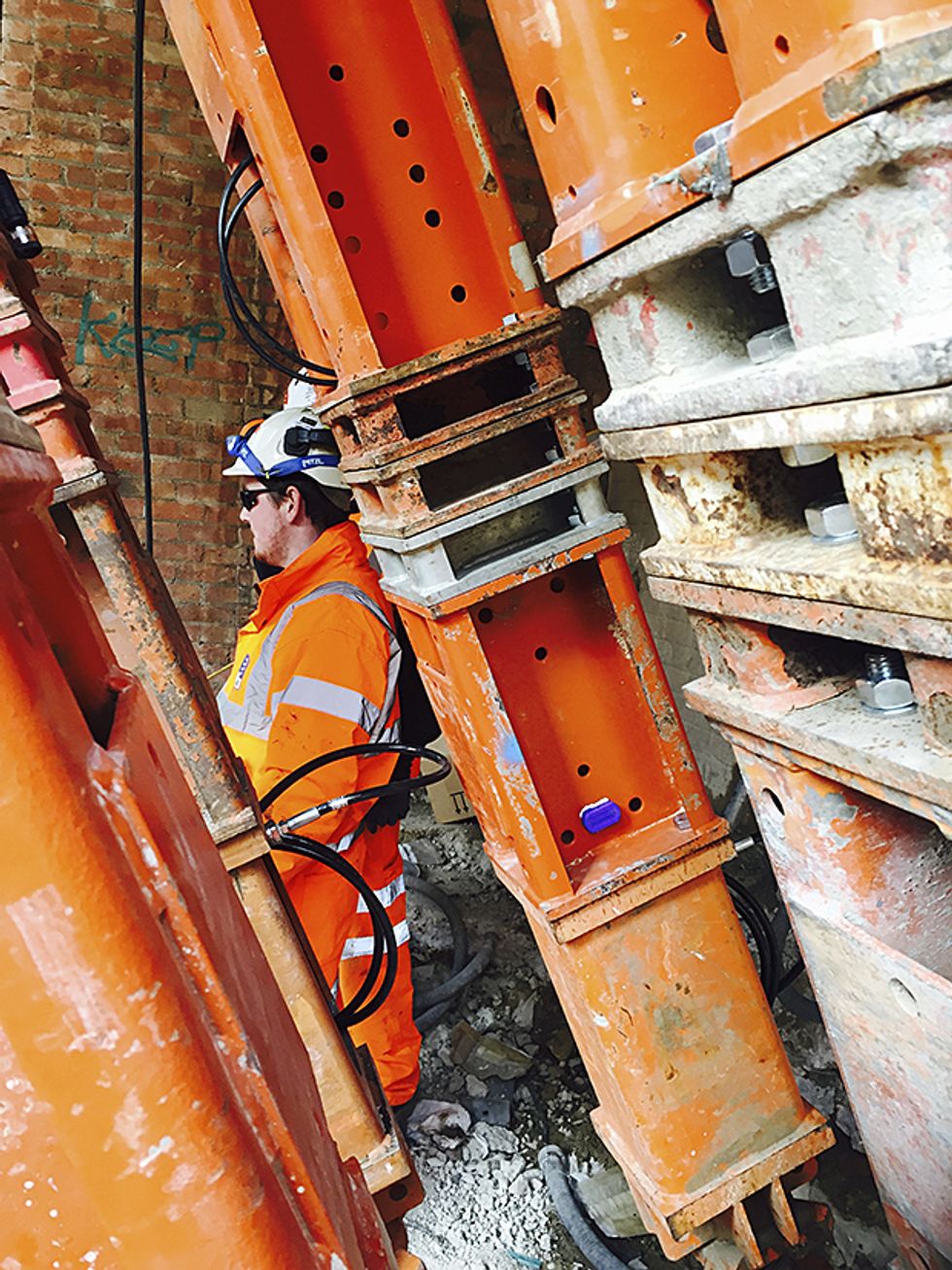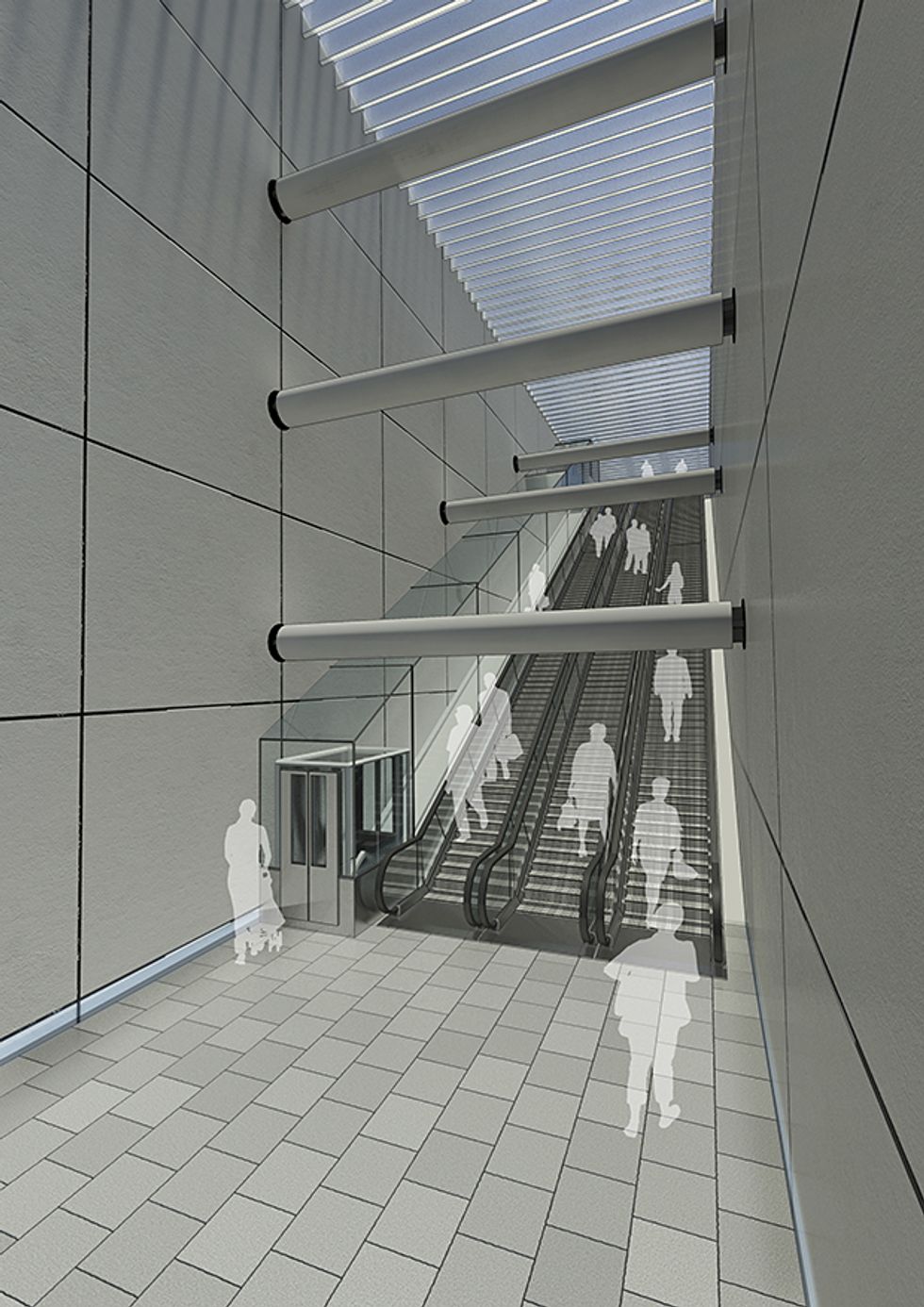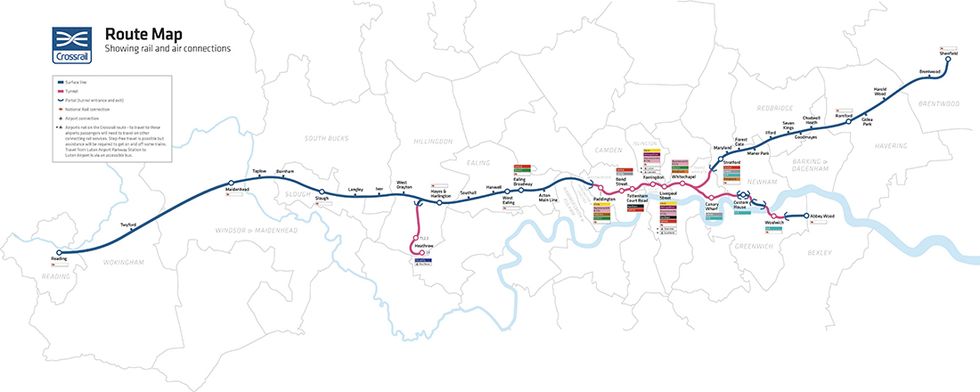London’s Crossrail Is a $21 Billion Test of Virtual Modeling
Every component in Crossrail, London’s new underground train network, will be digitally tracked via an intricate 3-D model
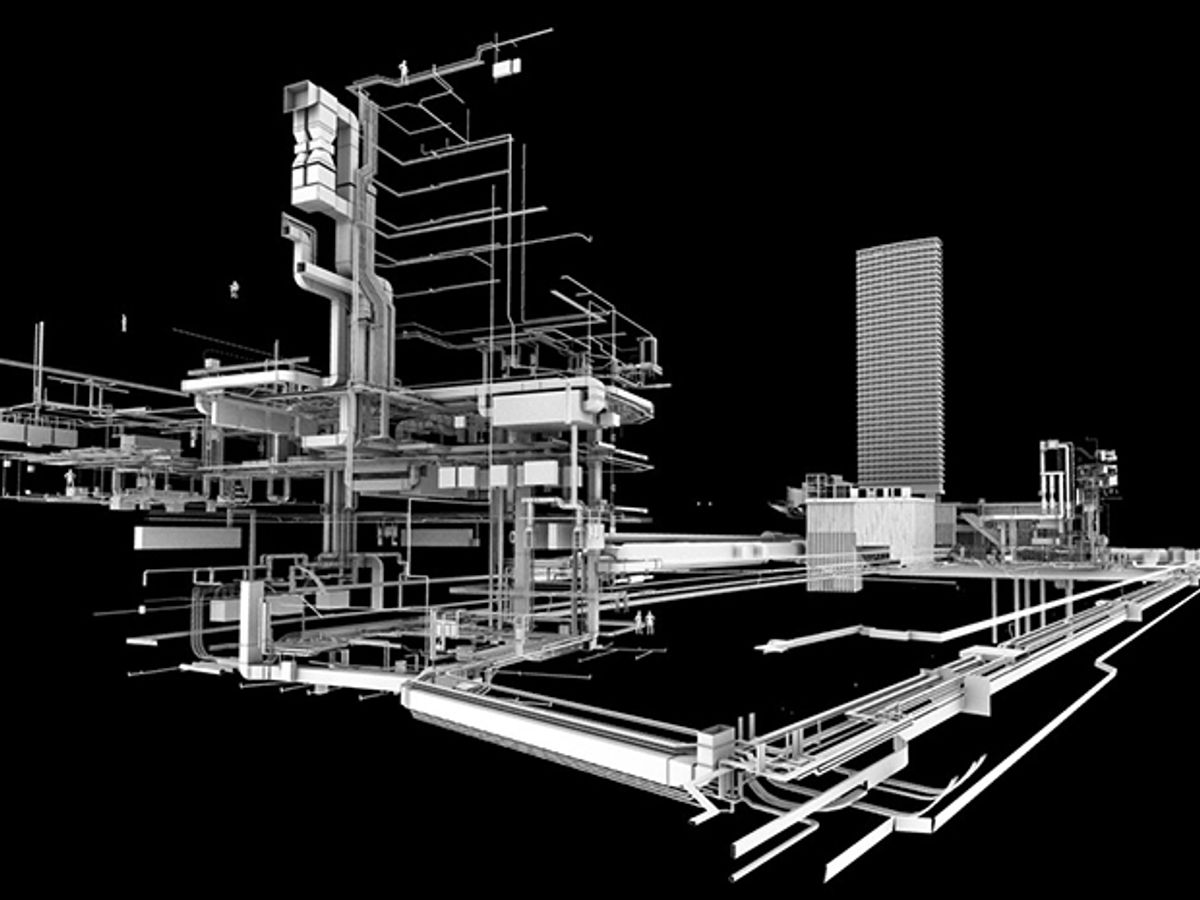
As the River Thames meanders eastward through London, it horseshoes around a lobe of land called the Isle of Dogs. In the 19th century, the area boasted one of the world’s busiest dock complexes, but by 1980 it had deteriorated into an industrial wasteland. More recently, thanks to massive redevelopment, the area has blossomed again to become Canary Wharf, an enclave of glittering glass skyscrapers that is now a global financial center. And here, in the murky waters of the North Dock, sits one of the largest and sleekest stations in London’s newest railway: Crossrail.
With a £14.8 billion (about US $21 billion) budget, Crossrail is currently the biggest engineering project in Europe. Since construction began in 2009, it has bored 42 kilometers of tunnels beneath Central London, creating a subsurface rail network that will speed passengers between the eastern and western fringes of the city. Its 40 stations, 10 of them completely new, will connect with existing National Rail and London Underground lines. The first Crossrail trains will start running in 2017, and when the network is fully open in 2019, it will shuttle an estimated 200 million passengers every year.
The tunneling was completed in May 2015, to much fanfare. But Crossrail is not just about digging—it has been a hotbed of innovation. The entire network was designed in a 3-D virtual environment; once the railway is up and running, a version of this 3-D model will help managers monitor, from a tablet, countless electrical components and systems across the network. “We’ve built two railways—one real, one virtual reality,” says Rhys Williams, the head of mechanical, electrical, and public health for Crossrail. He says one of his goals is to show how transport networks can become safer, smoother to run, and cheaper to maintain by using smart design coupled with the latest technology. And so everything about Crossrail—the escalators and elevators, lighting, ventilation, communication, the railcars themselves—is being engineered to reduce energy use, improve safety, and streamline operations.
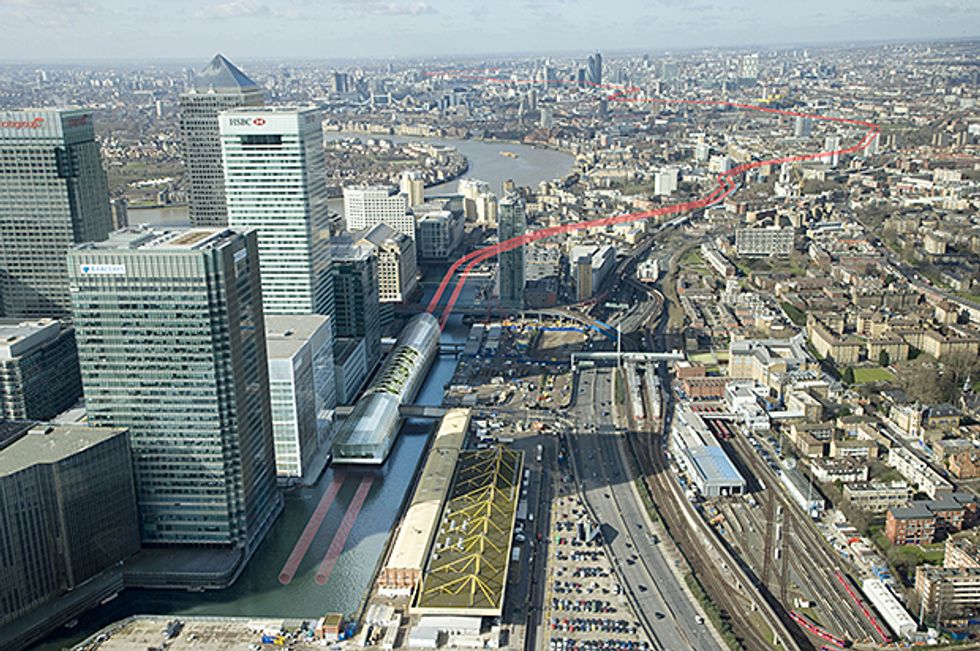
Already, the project is setting standards that are being adopted by other transport networks in the United Kingdom and providing a test bed for digital technologies that could revolutionize megaconstruction. “The whole approach to making it smarter—a lot of that has happened for the first time on Crossrail,” says Robert Mair, head of civil and environmental engineering at the University of Cambridge, in England, and a consultant to the project. “Crossrail really is a digital railway.”
I first visited the Canary Wharf station in October. Major construction had concluded a month earlier, and the station is a cavernous and pristine shell. From the outside, the gracefully curved timber lattice roof juts out like the prow of a ship. Inside, it’s all gleaming marble floors and polished metal, nearly devoid of people. The next step will be to install ticket barriers, platform doors, and all the other furniture and fittings of a major transport hub.
Today, though, the ticket hall looks more like a dance floor. “Are you ever tempted to have a party down here?” I ask Williams. In fact, I’m told, just 10 days after construction was officially completed, London’s Evening Standard newspaper held a splashy event here to launch its annual “1,000 power list,” celebrating the capital’s movers and shakers. (“There’s not one single category for engineering,” says Williams, with a sigh.) The paper brought in a bar and a choir and hung the ceiling with more than 1,000 glowing globes.
For history buffs, the party harks back to an earlier tunnel-based fete held nearly two centuries earlier and just 2 km away. In November 1827, master engineer Marc Brunel and his son, Isambard, threw a banquet to boost public confidence in their partly completed Thames Tunnel, which was to become the first transport tunnel beneath a major river. First used by pedestrians, it later was opened to trains, which continue to trundle through it today. Like Crossrail, the Thames Tunnel was an engineering marvel, built with the aid of the elder Brunel’s tunneling shield—a cast-iron, three-story framework that kept the ground from collapsing while workmen hacked away at the bare earth. On a good day, they might make 30 centimeters of progress.
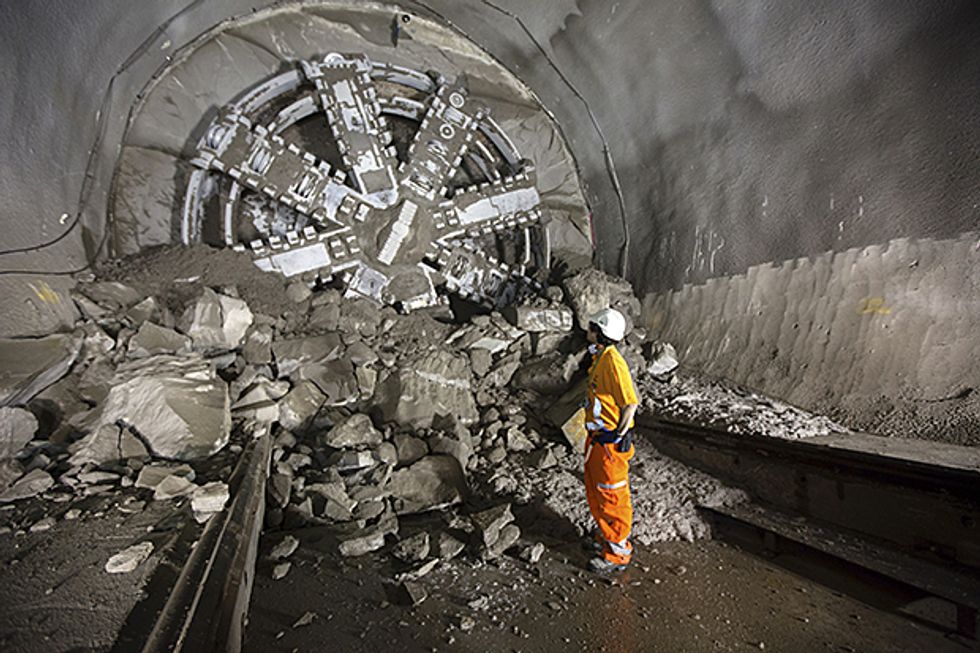
In contrast, Crossrail’s eight massive tunnel-boring machines, each equipped with a 7-meter-diameter cutting head, averaged 38 meters per day. Collectively, the machines gouged out 6 million metric tons of earth, digging as much as 40 meters below ground in places and securing the fresh tunnels with concrete rings as they went.
All those new tunnels and stations will provide much-needed relief to London’s overburdened transportation system. Throughout the last century and a half, the expansion of the London Underground subway network, known as the Tube, spurred the growth of London’s suburbs and helped create a sprawling commuter belt. Today the city’s population stands at 8.6 million, and it adds 100,000 newcomers each year. Meanwhile, the skyline is spiked with cranes and new office buildings that draw ever more people to inner London.
Roads are choked with traffic. The Tube’s spaghetti of 402 km of tunnels and surface lines and 270 stations sees more than 1.3 billion passenger journeys each year. Commuters often stand for their entire journey in hot and cramped conditions.
“Suburbia was created by the railways,” says Mark Lucas, who until recently worked for the borough council in Redbridge, in northeast London, where four Crossrail stations are being built. “But suburbia only works if you have good connectivity to Central London and beyond.”
Though the need for Crossrail has long been clear, the will to construct it was much slower in coming. Building this massive underground infrastructure beneath a 2,000-year-old city that already has plenty of underground infrastructure has been a herculean feat. Its designers, Williams declares, knew there was little room for error. Unlike, say, an office building, Crossrail’s tightly bored tunnels and underground stations won’t be able to accommodate lots of extra equipment later should any system be found wanting. “We can only do this once, and we have to get it right the first time,” says Williams.
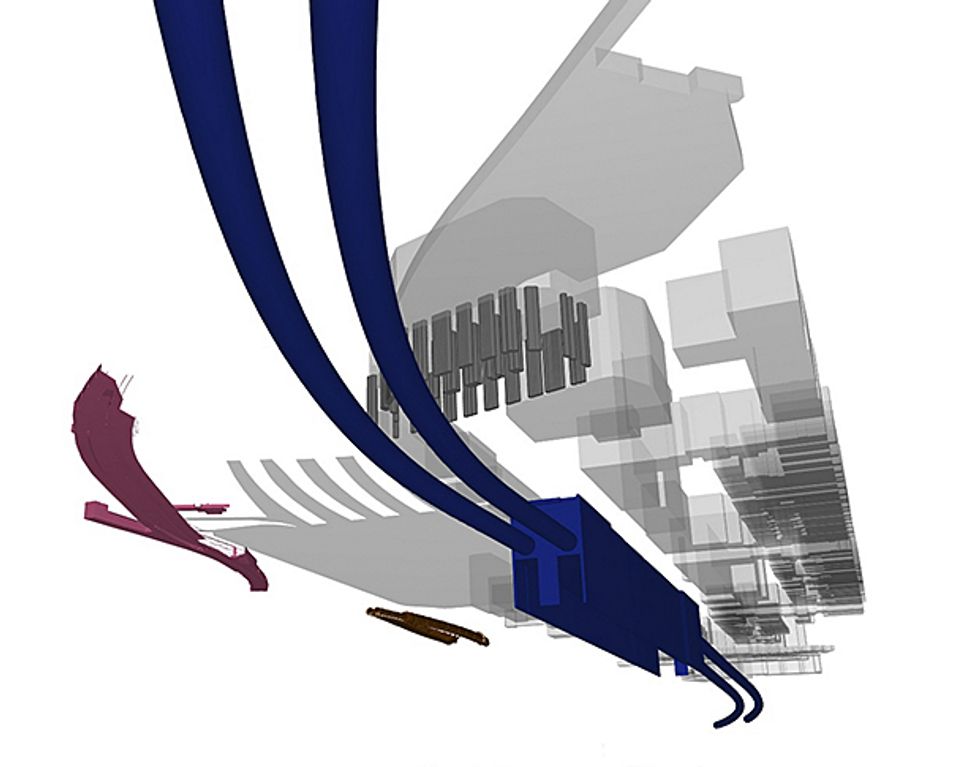
To ensure they get it right the first time, Crossrail’s designers and engineers have relied heavily on 3-D computer modeling. Widely used in the oil and gas industry and in automotive and aerospace manufacturing, the technique has also been catching on in civilian construction.
The Crossrail model actually consists of more than 250,000 little models joined together in a database and linked to another database containing all the data and documentation about all of the railway’s assets—from 1-watt LED lightbulbs to the giant fans that extract smoke in the event of a fire—as well as detailed descriptions of all the work that’s going on. Overall, the spatial data takes up a few terabytes, with the associated documentation adding a further 5 terabytes so far. “I don’t think building information modeling has been done on this scale anywhere in the world before,” says Williams.
The model saves time and money because it offers a common set of data for the thousands of contractors and consultants working on Crossrail. This arrangement helps reduce the disparities that can often arise between the work of two contractors. Contractors can also make changes to their part of the model, which, after review, get incorporated into the master model. Malcolm Taylor, head of technical information at Crossrail, says that previous projects he worked on used multiple methods to track the same information. “We got rid of all this software we didn’t need. All our information is now in one place,” Taylor says. “It’s saved millions of pounds per year.”
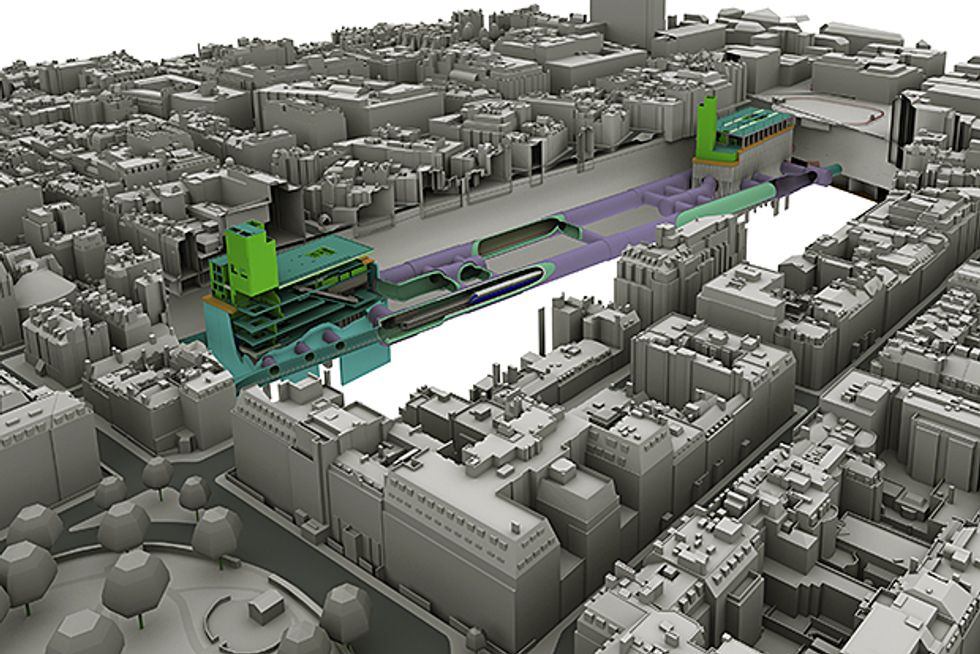
Once the construction of a space is completed, teams do what’s called a “point-cloud survey” using a rotating laser scanner that sends out coherent beams of light and catches the reflections from millions of surrounding points, building up an extremely precise 3-D image of the shape of what’s been built. This ground truth is then compared with the virtual model. As long as the match is within a centimeter or so, the model is updated with the laser survey data. Rare mismatches may indicate a problem with the construction that needs to be fixed, says Taylor.
The model will also become a crucial tool for tracking and managing Crossrail’s many systems once the railway is running. For example, each station has computer-controlled lighting that dims automatically when nobody is in the area and sends alerts when a fixture needs a new bulb. Another system oversees emergency equipment. Meanwhile, cameras will monitor the movement of people through corridors—if the pace slows to a crawl during rush hour, for instance, the system is designed to automatically redirect commuters along different corridors.
All this data and more will flow wirelessly to base stations and then on high-speed fiber-optic links to the Crossrail control center in northeast London. Managers viewing this information within the virtual model will be able to zoom in on an area of interest and check the operation and maintenance logs for a specific component. They’ll also be able to access the model through a tablet computer. “We’re giving them something they’ve never had before—a maintenance manual on an iPad,” says Williams.
The model even features an augmented-reality interface. Workers are able to hold an iPad up to a station wall, for example, and see a virtual view of the underlying electrical wiring and ductwork overlaid on the wall. The image of the wall is simply what the iPad’s camera is seeing; the image of what’s behind the wall is generated from the model based on the iPad’s coordinates as determined by GPS (when it’s available) and Bluetooth beacons. It’s a handy feature to avoid accidentally drilling holes through cables and to make sure things fit before they get to the site.
A geographical information system was used to create Crossrail Maps, an application that will allow Crossrail employees to query a particular location of London on a map and then dive into the Crossrail assets there. “We can click on a station and then on a defined space, such as a room,” Taylor explains. “Because every asset we create has a set of x, y, and z coordinates, we can call up all the assets in that room from another linked database and get all the information about each one.” Previously, locating a component meant digging through architectural drawings and archived manuals. “What would normally have taken many minutes—and sometimes hours—can now be done in seconds,” Taylor says.
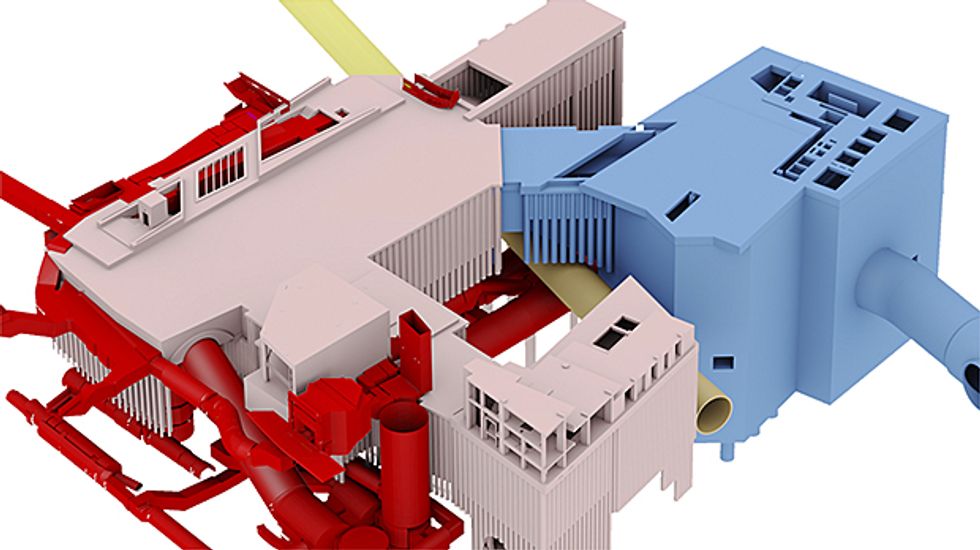
Crossrail’s trains are not the short, skinny rattletraps of the ancient Tube network. They are full-size, state-of-the-art trains, each one able to carry up to 1,500 people at a time. Accordingly, Crossrail has much longer station platforms and wider tunnels than does the Tube.
Those tunnels, 7.1 meters in diameter, posed a particular challenge. The settling of the earth increases with the square of the tunnel’s diameter, so engineers had to figure out how to prevent buildings above them from sinking or tilting. To protect the buildings, Crossrail’s engineers used a technique known as compensation grouting, developed in the 1990s by the Geotechnical Consulting Group, a London-based company cofounded by Robert Mair, of the University of Cambridge. It involves drilling a horizontal fan of narrow tubes into the earth directly above where the tunnel will be bored and then fitting the tubes with pipes that can dispense liquid cement. On the surface, workers affix optical prisms to surrounding buildings, and then a surveying instrument known as a theodolite bounces laser beams between the prisms, monitoring their precise locations as the tunnel is bored. If a building moves, the laser beams fall out of alignment, and workers promptly pump cement into the fan of tubes to strengthen the surrounding ground. Remarkably, no buildings were damaged during the digging. “These large tunnels have been constructed under literally thousands of buildings, and they have all been protected,” says Mair.
Construction engineers also used laser guidance to steer a tunnel-boring machine through the tightest spot in the network, at Tottenham Court Road station, where two Tube lines already intersect amid a tangle of pipes, cables, and sewers. Here, the giant digger managed to thread through a narrow gap that left just 85 centimeters’ clearance above one platform tunnel, and only 35 cm below an escalator.
During construction, engineers have been able to monitor the status of tunnels, shafts, and stations thanks to inexpensive wireless sensors and fiber-optic cable. Mair and his colleagues at the Cambridge Centre for Smart Infrastructure and Construction (CSIC) developed the real-time monitoring technology, and it’s helped them assess factors like the external stress on a tunnel. Mair’s team embedded cheap optical fibers into the concrete walls; the scattering of light along the fibers reveals how much strain they’re under. Mair says this monitoring will help to determine if the tunnels were built stronger than they really need to be. Such information could help make future designs less expensive.
Meanwhile, a spinoff of the CSIC called UtterBerry has been using Crossrail to test low-power wireless sensors that can monitor not only strain but also temperature, humidity, and many other aspects of construction work. Wireless sensors have been used in construction for more than 20 years, but they have typically been heavy, weighing 1 kilogram or more, with battery lives measured in weeks. An UtterBerry weighs just 15 grams and can operate for more than a year on one charge. In principle, an engineer could carry hundreds of them at once and mount them in a tunnel over the course of a day.
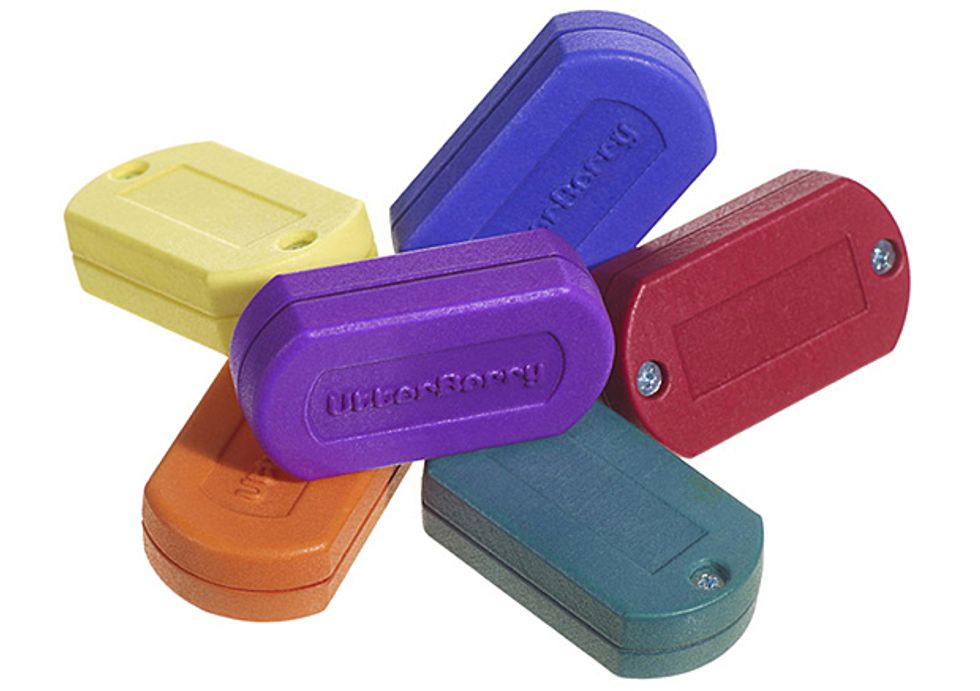
Heba Bevan, a Ph.D. student at CSIC, designed the small sensor as a classroom project. Unlike conventional sensors, she says, UtterBerries collect readings only when they need to, crunching the raw data with an ARM Cortex processor. By tracking changes in temperature and humidity, for example, the sensors can calculate how the weather might be causing a concrete panel to expand or contract; any expansion or contraction that exceeds such expected seasonal changes would require further investigation. And if one UtterBerry detects unusual vibrations or some other anomaly, it can tell other units in the area to up their sampling rate to boost the overall quality of data being gathered.
UtterBerry’s first project for Crossrail was in late 2012, and Bevan founded the company the following year. Her full-time staff of five just won a contract to provide yearlong sensor monitoring for another major U.K. construction project.
“Usually it’s hard for smaller companies to get into construction,” says Bevan. “But Crossrail has really encouraged this.” In the future, she believes that sensors like these won’t be added as an afterthought but rather designed into a bridge, building, or tunnel itself, to provide lifetime monitoring from construction to demolition.
Down on the platform at Canary Wharf, I can hear the relentless noise of hammering and drilling emanating from further down the tunnel. Later, a mobile gantry will lay rails on top of the ties, followed by a 465-meter-long “concreting” train that will pour its load around the ties to fix everything in place. Then another train will install high-voltage cable, to provide power in and around the tunnels. The trains themselves will draw electricity from 25-kilovolt overhead lines, so that they can travel seamlessly between Crossrail and the aboveground train system.
Canary Wharf’s escalators sweep upward from the platform, and although they look fairly conventional, they’re not. Unlike the elderly, power-hungry machines still found in some Tube stations, which break down frequently and can take months to refit, the Crossrail escalators rely more on off-the-shelf replacement parts, which will speed up maintenance. Thanks to machining and casting techniques borrowed from the aircraft industry, the parts are much lighter, too.
About 85,000 people will stream up and down these escalators every day once Canary Wharf opens in late 2018. At the Liverpool Street and Farringdon stations, there will even be inclined, glass-walled elevators that travel at a 30-degree angle right next to the escalators. “Kids going up the escalators can be waving to mum, who’s in the inclined lift with the twins in a buggy,” says Williams.
A handful of inclined elevators are operational in Europe and the United States (at the Huntington Metro station in Alexandria, Va., for example), he adds, but Crossrail is introducing them to the U.K. and setting the U.K. standards for how these elevators should be fitted. His team has also convinced Tube engineers to take up the technology. Last October, Greenford station became the first Tube station to have an inclined elevator.
“A few years ago, the prevailing attitude was, ‘My granddad didn’t do it like that,’ ” says Williams. “But now they are championing these works.”
Back in Williams’s office, I ask what’s still up in the air as this megaproject enters its final phases. Rather a lot, it turns out. Despite the huge amount of construction work that has already been completed, many aspects of Crossrail do not yet have an agreed-upon final design. That’s because the complexity and uncertainty involved in building large underground structures means that detailed “fit out” designs are begun only after it’s fairly clear how the space will look.
In answer to my question, Williams waves at some tall stacks of paper. “All of this,” he says with a smile. Patting one stack, he adds, “This one is [the design for] Woolwich station. It’s only just arrived, so we haven’t started the design review yet.” He hopes the remaining design reviews will be done by the end of July, so that the fit-out work can start in earnest on these stations. “The only part of Crossrail that we’ve actually finished is the academy,” he adds.
He’s referring to the Tunneling and Underground Construction Academy in Ilford, a facility that opened in 2011 to train more than 10,000 people to work in Crossrail’s tunnels. The tunnels and stations themselves have been a valuable proving ground for hundreds of young engineers. Many of them could move on to Crossrail 2, a north-south twin that (if approved) would be built from about 2020 to 2030. Williams believes that the lessons learned on Crossrail could make that project run much more smoothly.
Though it hasn’t even opened yet, the new railway system has already won over some key people. Christian Wolmar, a prominent transport journalist who last year campaigned to be mayor of London, is as supportive of Crossrail as he is opposed to some other big infrastructure projects. He has skewered HS2, the U.K.’s proposed high-speed railway from London to Birmingham, Manchester, and Leeds, as “the wrong scheme in the wrong place.” But ask him about Crossrail and his enthusiasm is unbridled.
“It’s a game changer,” Wolmar says. “The impact is going to be massive. People will flock to it.”
Meanwhile, Crossrail’s opening date looms, and Williams and others continue to push ahead on all fronts. Their efforts, they hope, will be an enduring engineering legacy. “We’re not building this just for the full Crossrail opening in December 2019,” says Williams. “We’re looking at the next 120 years.”
This article appears in the April 2016 print issue as “The Digital Underground.”
